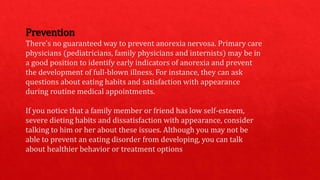Anorexia nervosa is an eating disorder characterized by an abnormally low body weight from severe food restriction and an intense fear of gaining weight. People with anorexia place high value on being thin and use extreme efforts like restricting food intake, induced vomiting, or excessive exercise to lose or prevent weight gain. Anorexia has serious physical and psychological complications and can be life-threatening but treatment helps restore healthy eating habits and reverse complications.













